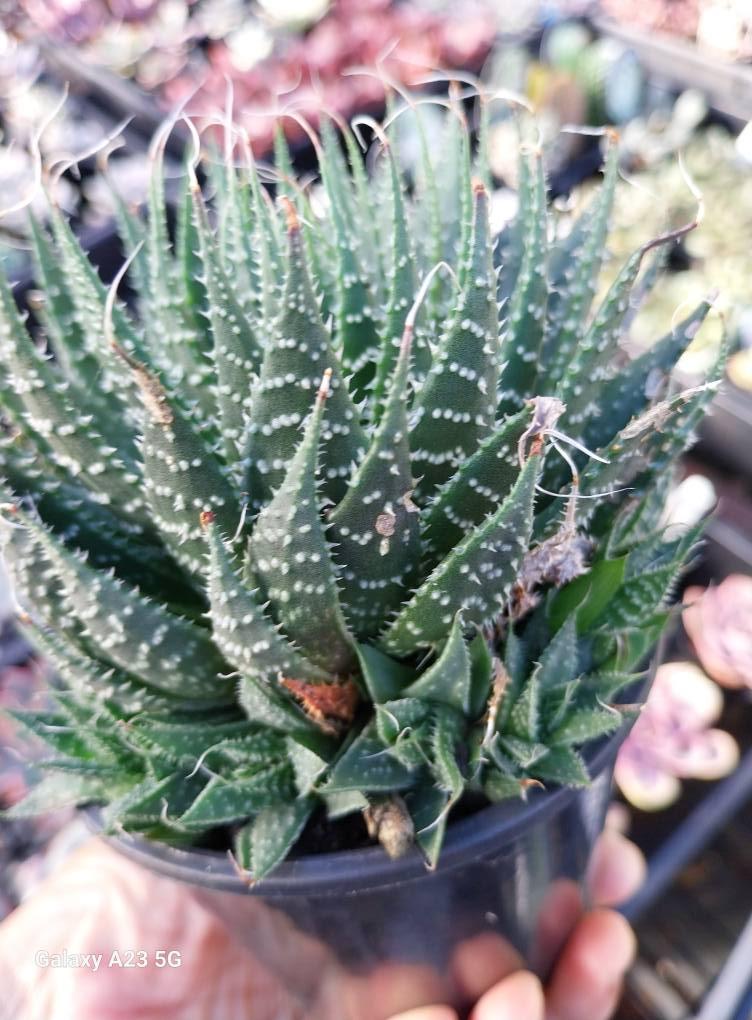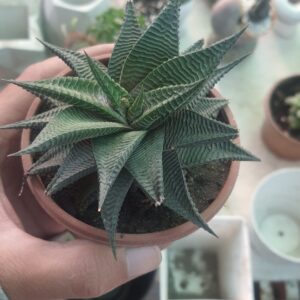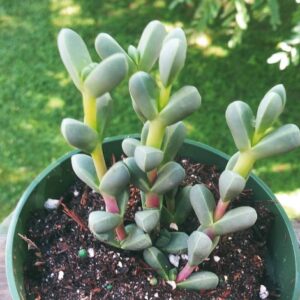✨🌿 The Spiderweb Succulent is known as Haworthia arachnoidea.
The Spiderweb Haworthia is a fascinating succulent species that is native to South Africa. Its scientific name is Haworthia arachnoidea. The tiny, white, hair-like threads that develop along the leaf edges, giving it a spiderweb-like appearance, give it its name. Its small rosette form and this characteristic make it a popular choice among succulent collectors.
Because of its low maintenance needs and distinctive aesthetic appeal, this plant is perfect for windowsills, little containers, rock gardens, and indoor collections.
🌿 Botanical Summary
Scientific Name: Haworthia arachnoidea
Family: Asphodelaceae
Typical Names: Haworthia arachnoidea, Spiderweb Haworthia
Origin: South Africa
Growth Pattern: A little succulent that grows in a rosette-like fashion at a low height
Dimension:
Height: 2–4 inches (5–10 cm)
Width: 4–6 inches (10–15 cm)
Appearance
Leaves:
Its flesh is triangular, pointed, and ranges in hue from green to dark green.
The margins of each leaf are lined with thin, hair-like cilia that resemble a fragile spider web.
Leaves frequently develop in a close, symmetrical rosette.
Growth Pattern:
forms clumps over time through offsets
Found in rocky, shaded crevices in nature
Flowers:
Creates long, slender flower spikes that have little tubular white flowers with green or brown veins.
Usually blossoms between late spring and early summer
Demands for Lighting
In the house:
Prefers bright, indirect light
Perfect for windows facing north or east
Can handle lower light levels, but grows more slowly
Outside:
Does well in filtered light or partial shade
The leaves and fragile cilia should be shielded from the intense midday sun, which can burn them.
Adequate lighting improves leaf color depth and emphasizes the spiderweb-like strands.
Humidity and temperature
Temperature:
Best temperature range: 18–27°C (65–80°F)
Can withstand brief dips to 5°C (41°F), but is not frost resistant
Best suited for USDA zones 9–11
Humidity:
Likes humidity levels that are low to moderate.
The rosette’s trapped moisture makes it prone to fungal problems, thus adequate air circulation is crucial.
💧 Water Plan
Spring to Autumn (Growing Season):
Water when the top 1–2 inches of soil are dry
Usually, every 10 to 14 days, depending on your climate
Employ the soak and dry technique: saturate the soil with water, then let it dry completely before watering again.
Winter (Dormancy):
Water less frequently, around once every three to four weeks
To prevent rot, avoid maintaining the soil constantly moist.
The most frequent problem is overwatering, which can cause fungal infections or decay at the base of the leaves.
Requirements for the Soil
Type:
Needs gritty, well-draining soil
Suggested mix:
half-and-half cactus and succulent mix
25% pumice or perlite
25% rough sand or grit
pH: Between moderately acidic and neutral (6.0–7.0)
Make sure to use pots with drainage holes.
🌾 Fertilization
During the active growing season, apply fertilizer (spring and summer):
Use a diluted, well-balanced cactus or succulent fertilizer (half strength).
Use fertilizer every four to six weeks.
Do not fertilize during the dormant season (fall and winter).
Maintenance and Pruning
Plant that requires little care
Take out:
To avoid rotting, remove any dead or dry leaves from the base.
The spent flower stalks following the bloom
Sometimes, a slight dusting of the leaves enhances photosynthesis.
Handle with care to prevent injuring the delicate hairs on the leaves.
🌿 Propagation
Offsets (Pups):
Gradually creates offsets at the base
When offsets have roots and are well-formed, gently separate them.
Let the cuttings callous for a day or two, then transplant them into dry, well-draining soil.
Seeds:
Rare and slow; usually propagated by offsets for the best results
🛡️ Frequent Issues
Overwatering: leads to rot and mushy leaves
Underwatering: Could lead to shriveling
Susceptible to pests:
mealybugs
Mites in spiders
Insects that are scaled
Regular inspections and therapy using neem oil or insecticidal soap can aid in preventing infestations.
⚠ Toxicity
safe for animals and people
Even though it’s safe for houses with pets, it’s still preferable to avoid nibbling to safeguard the plant.
🎍 Decorative Use
Ideal for:
plants for the windowsill or table
Terrariums with open, breathable designs
Little rock gardens
Arrangements that are succulent
Its small shape and distinctive spiderweb-like leaf edge make it a striking addition to any collection.
At the end, there is a conclusion.
Because of its small size and delicate spiderweb-like appearance, the hawthoria arachnoid is a stunning, low-maintenance succulent. With the right care, it can flourish and spread for many years, adding beauty and intrigue with its bright, indirect light, careful watering, and well-draining soil.
Office Plants, Succulents
Haworthia arachnoida
₨650.00
Haworthia arachnoida
Web-textured succulent with spidery leaf structure and dense rosette form, adding drama and contrast to plant displays.





Reviews
There are no reviews yet.